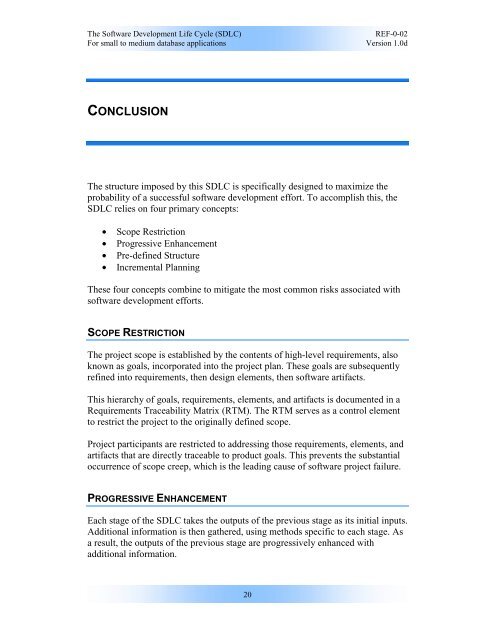sdlc
Create successful ePaper yourself
Turn your PDF publications into a flip-book with our unique Google optimized e-Paper software.
The Software Development Life Cycle (SDLC)<br />
REF-0-02<br />
For small to medium database applications Version 1.0d<br />
CONCLUSION<br />
The structure imposed by this SDLC is specifically designed to maximize the<br />
probability of a successful software development effort. To accomplish this, the<br />
SDLC relies on four primary concepts:<br />
• Scope Restriction<br />
• Progressive Enhancement<br />
• Pre-defined Structure<br />
• Incremental Planning<br />
These four concepts combine to mitigate the most common risks associated with<br />
software development efforts.<br />
SCOPE RESTRICTION<br />
The project scope is established by the contents of high-level requirements, also<br />
known as goals, incorporated into the project plan. These goals are subsequently<br />
refined into requirements, then design elements, then software artifacts.<br />
This hierarchy of goals, requirements, elements, and artifacts is documented in a<br />
Requirements Traceability Matrix (RTM). The RTM serves as a control element<br />
to restrict the project to the originally defined scope.<br />
Project participants are restricted to addressing those requirements, elements, and<br />
artifacts that are directly traceable to product goals. This prevents the substantial<br />
occurrence of scope creep, which is the leading cause of software project failure.<br />
PROGRESSIVE ENHANCEMENT<br />
Each stage of the SDLC takes the outputs of the previous stage as its initial inputs.<br />
Additional information is then gathered, using methods specific to each stage. As<br />
a result, the outputs of the previous stage are progressively enhanced with<br />
additional information.<br />
20



